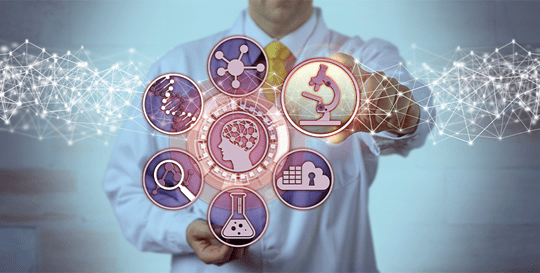When it comes to the types of Clinical Information Systems that healthcare providers use daily, organizations typically have two key options available to them. The first is building their own on-premises infrastructure, keeping everything entirely in-house and maintaining everything themselves. This certainly offers the deep sense of control that is important in these environments, but it's also enormously costly—financially and timewise. The second is to embrace cloud-based storage—a solution that houses data in an off-site data center that natively offers the security a healthcare organization needs.
Laboratory middleware connects instrumentation and analyzers with the Laboratory Information System (LIS), a computer system involved in inputting data, managing a variety of lab processes, and tracking samples and reports. One of the major benefits of using middleware in the lab is that it enables far more efficient use of laboratory automation—something that can lead to more efficient testing, lower operating costs and providing improved clinical services for both diagnosis and treatment.1,2
In the Cloud
Cloud computing simply means providing computing services—everything from analytics to servers—over the internet.3 Overall, cloud computing can be less costly, faster and more scalable than on-premises solutions.4 In contrast, on-premises services are set up and maintained entirely by a healthcare organization, although installation and maintenance can both easily be outsourced. For on-premises systems, all equipment is housed on-site and must be procured, installed, maintained and troubleshot by internal IT staff members.5
According to the U.S. National Institute of Standards and Technology (NIST), cloud computing is “a model for enabling ubiquitous, convenient, on-demand network access to a shared pool of configurable computing resources (e.g., networks, servers, storage, applications, and services) that can be rapidly provisioned and released with minimal management effort or service provider interaction.”6 With a web-based solution, an organization gets everything it needs—including cloud-based storage—without needing to worry about a massive upfront capital investment.
The major difference between the two—and indeed, the major benefit of a cloud-based solution—has to do with overall costs and maintenance. Cloud-based storage operates with >99% uptime.7 In the rare case that there is an issue, a service agreement with the cloud vendor ensures that the problem is fixed. All assets are delivered in an on-demand fashion over the Internet in exchange for one fixed, predictable monthly fee. Conversely, with an on-premises environment, if downtime is experienced, the internal IT staff is responsible for determining what went wrong and how to fix it quickly.
Another major benefit of the cloud is scalability. With an on-premises environment, adding additional capabilities or capacity may require the healthcare organization to purchase new equipment, set it up, interface it and maintain it. But with a cloud-based storage provider, adding additional resources is as simple as selecting a higher tier of service from the cloud provider.
Security and Privacy
When it comes to security and privacy, one of the main issues under discussion has to do with General Data Protection Regulation (GDPR) compliance. Since its inception, the GDPR has been seen as the toughest privacy and security law in existence.8,9 It's mainly focused on the European Union, but it also impacts every business that interacts with customers and clients in Europe. Meaning that even if your company physically exists in the United States, if you do business in Europe, you must be concerned with the GDPR.9
It's especially hard to manage given the sheer volume of data that must be collected and processed. Doing this all in-house wouldn't just be difficult—for a lot of businesses, it would be impossible.
The GDPR and other privacy regulations have prioritized protection of employee and consumer data. While good for consumers who are concerned about the privacy of their data, understanding and complying with all laws can be tricky. Compliance in one region doesn't necessarily translate to compliance in all regions—and even within a region, different places have different rules for how data can be stored and accessed.
Overall, privacy regulations put control over personal information back into the hands of the people, including healthcare patients. The collection and storage of patient data needs to comply with applicable regulations and stored in an accessible and protected system. Healthcare facilities have a say over the type of storage and where, specifically, those systems reside. They must choose and maintain the secured state of their data and institutional policies to mitigate the growing risks of cyberattacks.10
With an on-premises environment, it is up to the healthcare organization to ensure they're not in violation of any of these rules. That means verifying that they've not only procured the right type of hardware but also that it is configured in the right way and that the appropriate type of encryption is being employed. If those rules happen to change—as they often do—it falls on the organization to make sure they're still in compliance. If they're not, they could wind up on the receiving end of hefty fines and other penalties.
With a credible cloud-based provider, compliance is taken care of automatically. As long as you've chosen to partner with a GDPR-compliant company, the lion's share of the privacy regulations work will be outsourced.
Healthcare and the Cloud
Both LIS and Healthcare Information Systems (HIS) are designed to manage sensitive healthcare data11 and can be either on-premises or cloud-based. LIS is a component of a HIS and, as mentioned, is a specific type of information system that not only processes and stores but also manages patient lab results within the context of a laboratory processing and testing environment. HIS describes the overarching system that helps manage all aspects of a healthcare organization's virtual footprint. In addition to electronic medical records (EMR), this can include hospital reporting capabilities, policy information and even financial data. Cloud-based HIS systems are commonplace in the United States. Kaiser Permanente, The Mayo Clinic, and Chicago’s Rush University Medical Center are just three of the many examples of hospital systems using cloud-based applications.12,13
Adoption of cloud-based middleware has been slower across the European healthcare sector, primarily because of concerns around privacy and data security. However, given the associated improvements in patient care and in security coupled with the need for telemedicine during the COVID-19 pandemic,14 cloud-based systems are gaining popularity around the world for everything from ophthalmology to cardiac care.15–18
Johns Hopkins School of Medicine—one of the most widely renowned healthcare systems in the world—is one of many systems using a cloud-based solution called MyChart, an example of a cloud-based tool used by both patients and healthcare professionals alike. When a patient has a doctor's appointment or if they go in for blood work or testing, the results are loaded into MyChart for review ahead of the next appointment. If that patient were to go to another provider for a second opinion, that new provider can also access the same records as long as they are given permission. It's an efficient, secure way to share patient health records with those who need to see them and help everyone involved make the most informed decisions possible as quickly as possible.2
In the end, making the move to the cloud brings with it a wide range of benefits that cannot be ignored. Not only is it less expensive than a more traditional on-premises environment, it also improves data sharing among healthcare providers as compared with on-premises systems, allowing for more efficient care. Security is offered directly from the provider with updates and new components added automatically, leaving healthcare professionals in a better position to focus on their patients, which really is the most important benefit of all.
Learn more about Laboratory Information Systems and Middleware at Beckman Coulter

 English
English





